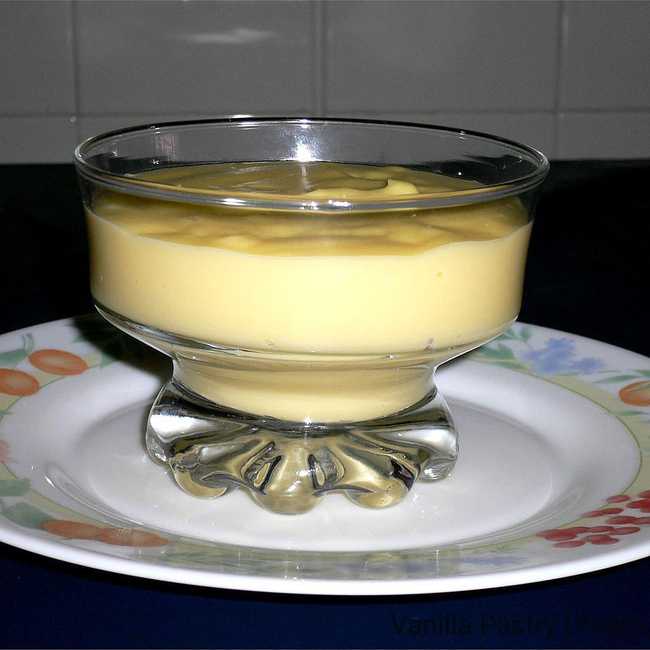Vanilla Pastry Cream
This recipe for Vanilla Pastry Cream is a classic French recipe that is perfect for filling tart shells, eclairs, cream puffs, and more! It is made with milk, eggs, sugar, flour, and vanilla extract. Ingredients 2 cups milk 1/2 cup white sugar 1 vanilla bean, halved lengthwise 6 egg yolks 4 tablespoons all-purpose flour 4…
This recipe for Vanilla Pastry Cream is a classic French recipe that is perfect for filling tart shells, eclairs, cream puffs, and more! It is made with milk, eggs, sugar, flour, and vanilla extract.
Ingredients
- 2 cups milk
- 1/2 cup white sugar
- 1 vanilla bean, halved lengthwise
- 6 egg yolks
- 4 tablespoons all-purpose flour
- 4 tablespoons unsalted butter, softened
- 1/8 teaspoon salt
Instructions
In a saucepan over medium heat, combine milk, sugar and vanilla bean. Cook until the mixture just begins to boil. Remove from heat and remove vanilla bean.
In a bowl, whisk together egg yolks and remaining sugar until light in color. Add flour and salt, mix to combine. Slowly dribble hot milk into the yolk mixture while stirring constantly.
When about half of the milk has been added, pour the yolk mixture back into the saucepan over medium heat. Using a spatula or whisk, mix pastry cream as it heats up, making sure to reach all corners of the pan when you stir. Bring mixture to a boil then let it cook for about 1 minute while stirring constantly. The mixture should be thick by now.
Remove from heat and add butter then strain if you want a smoother cream consistency (optional step). Pour pastry cream into a bowl, cover directly with plastic wrap to prevent skin from forming on top of cream surface. Chill in fridge then use within a few days
Nutrition Facts
- Serving size: 1/2 cup
- Calories: 200
- Fat: 10 g
- Saturated fat: 5 g
- Cholesterol: 110 mg
- Sodium: 80 mg
- Carbohydrates: 22 g
- Fiber: 0 g
- Sugar : 14g
- Protein 4g

How do you make pastry cream?
Pastry cream is a delicious, rich custard that can be used to fill pies, pastries, and other desserts. It’s made by cooking milk and sugar together until the sugar dissolves, then whisking in egg yolks and eggs so they don’t cook. The mixture is thickened with flour or cornstarch, then boiled until it becomes thick and smooth. Finally, butter and vanilla are stirred in for flavor.
How long can pastry cream sit at room temperature?
Pastry cream is a delicious and versatile ingredient that can be used in a variety of desserts. It is made from milk, eggs, sugar, and flour, and has a rich, creamy texture.
So, how long can pastry cream sit at room temperature? The answer depends on a few factors, such as the type of milk used and the environment in which it is stored.
Whole milk or heavy cream will spoil more quickly than low-fat milk or skim milk. This is because the higher fat content provides a perfect environment for bacteria to grow. For this reason, it is best to use pasteurized dairy products when making pastry cream.
The temperature of your kitchen also plays a role in how long pastry cream will last at room temperature. If it is very warm (above 80 degrees Fahrenheit), the cream will spoil more quickly. Conversely, if your kitchen is cool (below 70 degrees Fahrenheit), the pastry cream will last longer.
Assuming you are using pasteurized dairy products and storing the pastry cream in a cool kitchen, it should be safe to eat for up to four hours after it has been made. After that time frame, there is an increased risk of food poisoning due to bacterial growth.
How do you use creme patissiere?
Creme patissiere, also known as pastry cream, is a versatile and delicious ingredient that can be used in a variety of sweet dishes. Classic profiteroles and cream puffs are typically filled with creme patissiere, while chocolate eclairs are often filled with a chocolate version of the cream. Cakes like Boston cream pie and fruit tarts can also be made with creme patissiere as the filling, and it is also used to make mille feuille (a French dessert consisting of layers of puff pastry) and vanilla or chocolate pudding.
To make creme patissiere, you will need milk, eggs, sugar, flour (or cornstarch), butter, and vanilla extract. Begin by heating the milk in a saucepan over medium heat until it comes to a boil. In a separate bowl, whisk together the eggs, sugar, flour (or cornstarch), and vanilla extract. Once the milk has come to a boil, slowly pour it into the egg mixture while whisking continually so that the eggs do not cook. Pour this mixture back into the saucepan and cook over low heat until thickened. Remove from heat and stir in the butter until combined. Allow to cool slightly before using as desired.
What is the difference between pastry cream and custard?
Pastry cream and custard may seem similar at first glance, but they are actually quite different. The main difference between the two is in how they are used. Custards are firm, but creamy, while pastry cream is thicker because it contains more starch. This makes pastry cream ideal for use in pies and other desserts where a firmer filling is desired. Custards may be served warm, but pastry cream is almost always served cold. This is because custard can curdle when heated, whereas pastry cream does not have this problem.
Does creme patissiere need to be refrigerated?
Creme patissiere is a delicious French dessert made with eggs, milk, and sugar. It is typically used to fill tarts or pies, or as a pastry cream for cakes and other sweets.
So does creme patissiere need to be refrigerated? The answer is yes and no. If you use the cream immediately after it has cooled, it will have a silky smooth texture. However, if you refrigerate it, the texture will become firmer and may occasionally turn grainy. The flavor will still be great, but the overall consistency may not be as lovely.
Ideally, creme patissiere should be used within 2-3 days of being made for best results. After that time period, it’s still perfectly safe to eat (and often still tastes good), but the texture may not be quite as perfect as when it was first made.
Ask your question to our expert chef and get instant help.
Please provide details about your query with the recipe name.

